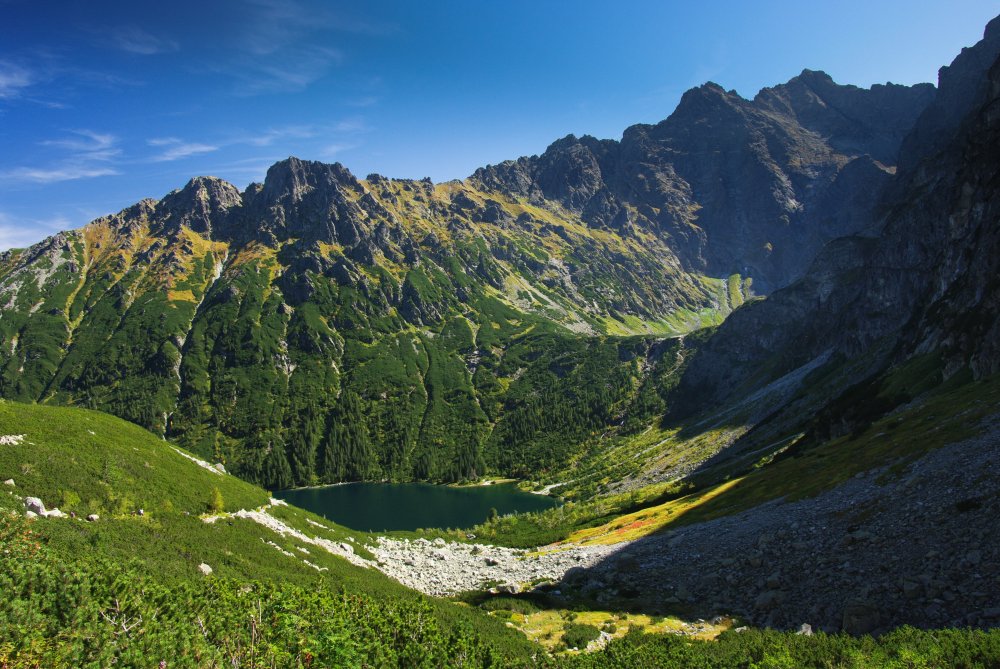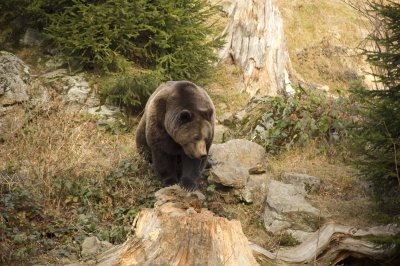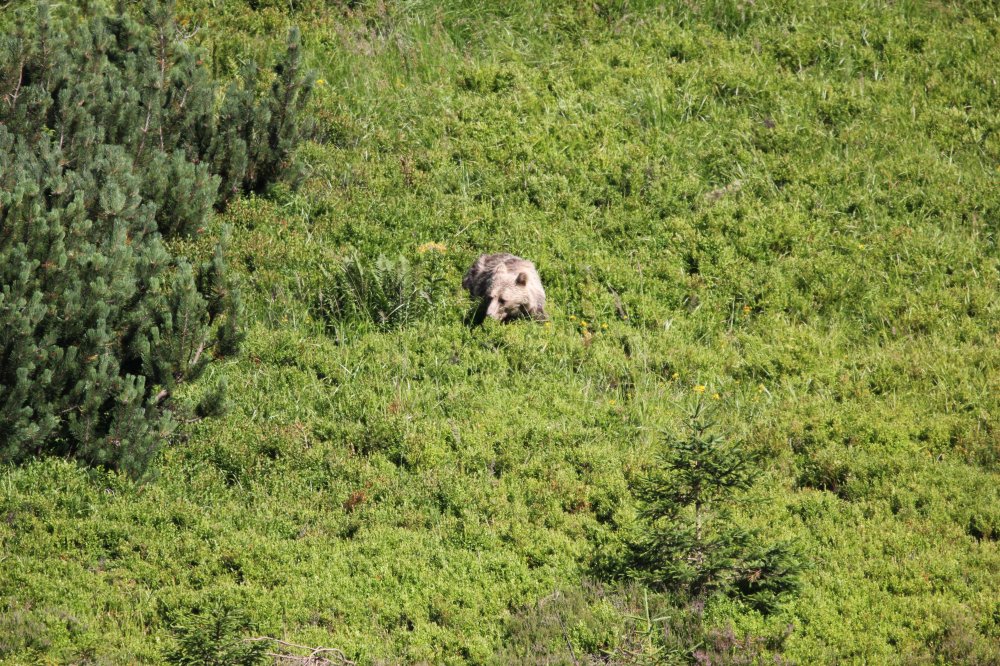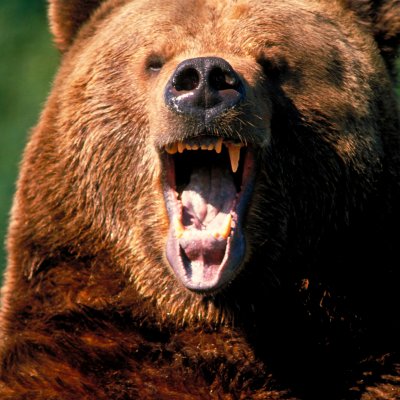

Experience is just everything. Experience is even to show a person what is a blueberry, how it looks like in nature. People only see that they buy blueberries in a bottle. But a good guide is also someone who can show people how blueberries grow, which plants are protected by law ... alongside observing bears, we try to teach clients some botany, fauna, flora. For example, today we saw a young viper snake that was warming up itself next to the tourist trail. Early in the morning, a rabbit was running ahead of us. In a silent valley we saw a beautiful huge deer with beautiful antlers along with chamois. Up on the horizon we could observe 7 chamois again.
I don't take many people to Bear Watching, max. eight people so they do not make a big noise. Because when they make noise, animals are scared away and we cannot see anything at all. However, noone said that the trip must look as I offer it. People who choose the trip can consult about changes in its course or number of people in a group. Children also take part in Bear Watching. In fact, kids are better at finding bears than parents. Parents already wear glasses (laugh). Children think about it as fun and so they can learn a lot from it. It is a precious moment for families to spend some time together doing something new. We meet each other in Podbanské and that is another nice fact on the experience day that you can go to the Tichá Valley by bike. So even if the bears are not seen, it's a nice trip in beautiful nature.

That is another thing we try to teach people. We teach them that it is way different than it is presented in the media. I talked to one ranger about the bear's attacks on man. There have been about 4 reported cases in the last 10 years. Even those situations were ... well, a mushroom picker somewhere "in nowhere" disturbed the bears / woodmen in Javorin were hacking at the trees in a bad location, the bear got scared and attacked them. It's always a moment of surprise for the game. The bear never waits for a tourist to attack him. Bears do not attack in general. We teach people that when a family with children is making a trip to nature, it is okay to be a little noisy, because when bears hear them from 200 meters, they start running away from people. And if there is a conflict with the bear, there is no need to panic. At that moment one should go silently in another direction, or the bear will leave first. Some people when meeting the bear saw that the bear stood on the hind paws. And so they thing to themselves, "Oh, it's goint to attack us!" But the opposite is true. When the bear is "on its four paws," its eyes are 60cm high. But when it stands on its hind paws , it can see from a height of 1.80 meters. So it only looks around and tries to smell the human or whatever it is. Bears are curious. And then they usualy run away.
It is always about the same places, the same walking trails - High Tatras, West Tatras, Tichá Valley. We must always stay on the marked road (the official walking trail). We can't go off to the sidewalk. That would be against the National Park. I also study old works, in which bears were tracked with bracelets / collars. Respectively, the works watched where the bear had lair. There are works in which the locations were specificaly wrote down. Although bears have their lairs often in a different placet hen before, so the work is sometimes a little pointless. But I can point out that in the past there was a lair or which way the lairs are built or how the lair look like...)

It depends. When there is a large uprooted tree in the forest, a „cavity“ is created and that becomes a bear's lair. For example, in the Western Tatras there is a part of the Tichá Valley which is made of limestone. It means that there are approximately 7 caves. Bears often use these caves as lairs. But caves are pretty high, so most people don't get into them. Or in places where there are granite cave-ins, there is a space so the bear entres this space, lines it with grass and sleeps there from November to March.
It depends on the season. It's different in the spring and different in the fall. In the autumn they are out of their lairs almost the whole day since they need to eat approximately 5 pounds of blueberries or other forest fruit per day so they have enough fat for the hibernation. They don't fish trout and we don't have salmons either. Justas they do not go on chamois or wild animals unless these animals are injured. They are good runners and good climbers, but they will not chase them. They want to save energy. They are more active in autumn. These days the valleys are pretty „lifeless“, only a few animals can be seen. First reason for this situation is, that it is warm outside and second reason is that they do not need to eat so much. Bears truly fascinate me because they're wonderful beasts. Very quiet beasts. Although they walk next to you, you often cannot hear them. They can only be heard when fighting with another male bear. But in past 5 years I have heard them in such a situation only once. It's a huge beast and i tis hard to explain to someone who didn't see it, someone who did not sit 200 meters away from it for at least half an hour... That must be experienced. The bear is like a big cat or a big dog. When the bears are playing somewhere and you watch them, you will find them to be like little children. They play together, they bite each other. It's really funny. He who once experienced it wants to see it again. Also because it's still different because every bear has a different color. One is silver / light brown / dark brown.
Before every Bear Watching, I tell the client to set their expectations to 10% so they don't expect us to come to the first place of our interest and see bears. You would not believe, but there are people like that and they can be quite annoying when they don't see a bear all day. I have to prepare them that there is a chance of seeing nothing that day. It also depends on the guide how he explain this fact to a person. The basis is that it will be a nice day on bicycles. But I can't say to the bear, "Half past seven we meet each other in that place." I always keep track of every hike and write down what we've seen. We usualy observe bears from about 200-300 meters. Relatively close but still far away. So the bear never comes to us. On the contrary, there is bigger probability that when bears hear us, they crawl into deeper forest and nothing happens. It can be observed with the eye, but we also have special binoculars. For every client we have a normal telescope that is quite large, but I always take a monocular with me. It is used only with one eye, zooms two times closer and does not quake because it is not in hand, but on a tripod.

One should not go alone to the mountains or forests. It takes at least two. Mountain rescue says so, guides say so. But if a man is alone, he has to be aware of the fact that he can meet a bear. It's good to be "armed" with a jingle bell on a backpack. For example, when I myself am in a valley all by my own, somewhere by the stream where the bear can't hear me, I clap my hands every 100 meters. The bear hears this sound and goes away. Or you can listen to play music so that you don't surprise the bears. But, of course, everyone who meets something two meters heigh with 300 kilos is afraid. Especialy people who see it for the first time. We - who follow them often into the valleys - already understand them. There is absolutly no need to go close to them. You can look from a safe distance, but do not scream or whistle. Do not surprise them. Just leave them.
Common sense says - keep away, do not take pictures, do not film, let it go and go away. I remember the situation when a bear with its „baby bear“ climed up a tree in Smokovec. There were many, I would say, unreasonable people. They were right under the tree taking pictures of them. Bears are generally not nervous, but this baby bears may have fallen down and a „bear mother“ would attack surrounding people in an effort to defend its baby. In order to have cool photos and videos on the Instagram, people dare to go to the bear very close and that's dangerous. What is happening in Smokovec, well ... sometimes there is a bear with little ones. Because of our garbage. This is a little problem. These bears are already apathetic, they are not afraid. However, this is no longer on our recommendation. This question must be addressed to the National Park and the State.
In case you are interested in spending your holiday little more adventurously do not overlook Adventoura webpage! In addition to (still unaccustomed) Bear Watching, you can choose a tourist package "From cottage to cottage" (7 days in the Tatras, always sleeping on a different cottage) or a sport option, when one is cycling about 270 kilometers around the Tatras in about a week. Adventoura also offers very popular rafting, guided tours (UNESCO sights, Dobšinská Ice Cave , Levoča Castle, magical yet unexplored village Liptovská Teplička, etc). And let us tell you one more curiosity - Adventoura is planning to declassify paddleboarding on the dams this summer and for the braver ones – paddleboarding white river Dunajec.
So if you still wonder where to go for a summer holiday, choose one of the comfy APLEND accommodation and experience an unforgettable moments in the High Tatras and surrounding in the words of Eleanor Roosevelt: „Do one thing every day that scares you.“
